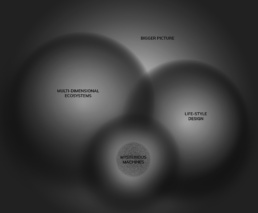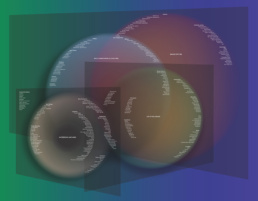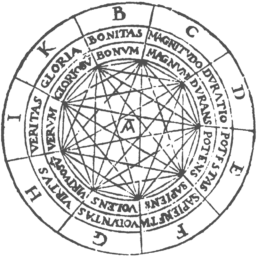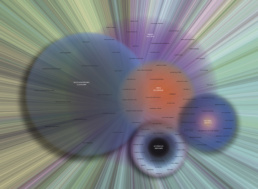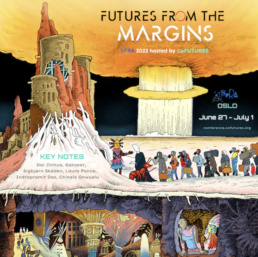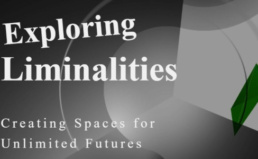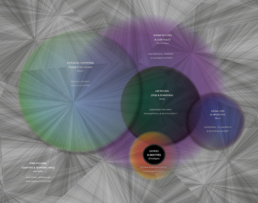Designing Post-Human Futures
Chapter in Carrillo, J. & Koch. G. (eds), Knowledge for the Anthropocene, Edward Elgar publishing, 2021.
If the TAC Future Canvas diagram has so far been used to structure a reflection on global transitions (Anthropocene, AI, post-colonial era, etc.), and served as a 'prospective topology', this essay laid the foundations of our methodological and pluriversal research on future worlds and on what we call the horizon of alien cosmologies.-The anthropological refoundation associated to the current paradigm shift, calls for both disruptive and interdisciplinary input and leads us toward the teachings of Francesca Ferrando’s post-humanist philosophy and methodology, that are crossed with learnings from Foresight, Anthropology, and those of LIID Future Lab (trend analysis, design of hybrid methodologies and conceptual diagrams).
Chapter abstract: The Anthropocene forces us to rethink the human condition at large, from the everyday individual gestures to shared life-styles, from productive uses to all social organizations, from development principles to atmospheric sustainability and space expansion. Simultaneously, science and technology also challenge the limits of human nature and of life, whether via bioengineering, synthetic biology, neuroscience, algorithms or the post-truth paradigm, that create a deep identity and ontological insecurity. At all scales anthropological fundamentals and certitudes are shaken and call for innovative futures and holistic cosmologies to lead human action. Learning from foresight, design, anthropology, science-fiction and post-human studies, this article introduces “Toward Alien Cosmologies”, a conceptual canvas and critical topology to envision future horizons, guide the co-design of post-human future worlds, and facilitate futures literacy and empowerment.
Keywords: Anthropocene, Design, Foresight, Post-human Studies, Anthropology, World-Building, Futures Literacy.
About ‘Knowledge For the Anthropocene’
Human-induced environmental impacts are bound to disrupt our way of life in deeper ways and at wider scale than anything previously experienced by mankind. Global existential risks challenge the conditions of the Biosphere that prevailed through the Holocene, the geological epoch that saw human civilizations flourish. However, the current knowledge base seems inadequate to help us cope with such realities. What relevant knowledge will become critical to deal with deteriorating environmental conditions? How can science, technology, innovation and education be radically transformed for adequately responding? How can societies and governments continue to function? How need our mind-frames evolve? These and other related questions are addressed in a simple and direct manner by a set of international specialists. The common purpose is to provide a general perspective on the role that knowledge –the most important leverage to human action, may need to play in the unfolding circumstances of the Anthropocene.
1 - The Anthropocene, A Post-Humanist Future Challenge
The concept of Anthropocene epitomizes a period of history where the actions of mankind on Earth have reached the point of modifying its ecosystems, atmosphere and life conditions, creating an era similar to a geological era, no matter where its precise starting point is. The Anthropocene is a critical anthropological paradigm marking that core planetary evolution turn, asking mankind to be aware of and responsible for its impact, and calling for a civilizational transformation toward resilient uses and ways of living. The Anthropocene is both a critical wake-up call and an impulsion to redesign the life conditions on earth. Humanity needs to emancipate from anthropocentric and predatory economies, policies and lifestyles, most of which are rooted in the western humanist, progressive, liberal and modernist value system.
These conceptual frames gave full license to men’s freedom to innovate in all matters and have shaped most of globalization standards. For that reason, the future is bound to be “post-humanist” and we paradoxically need to invent it, which means redefining the way we project ourselves toward the future, create and lead a sustainable and “future-proof” change. The earthquake of the COVID-19 pandemic and the radical adaptation of the entire humanity has shown how systemic change is possible and has started prototyping what could be the “new normal,” somehow paving the way for a now urgent environmental transition. It is time to act and eventually enforce futures, not just predict and anticipate them as an outside performance we would watch. Whether we like it or not, we are inevitably included in the picture.
In order to explore and design Anthropocene futures and to open alternative perspectives to the collapse narratives, we cannot keep the same strategic tools and foresight methods, most of them being also rooted in western modernity and cognitive frames.
Imagination is a resource that needs to be mobilized to open the future horizon and engage in it. The Anthropocene forces us to rethink and reinvent the human condition at large, from the everyday gestures to shared lifestyles, from all social organizations to the atmospheric sustainability and space expansion. The paradigm shift touches on the cosmological order, as it touches on humanity’s visions of the world, its place in the universe, and its relation to knowledge, truth, existence, space and time, whether past, present or future.
Simultaneously, science, technology and the digital transition at large also challenge the limits and definition of human nature and societies, calling for an anthropological redefinition and leading to innovative post-human philosophies. Bioengineering, synthetic biology, neuroscience, AI and deep fakes bring profound ontological issues and uncertainties, making human-beings as alien as other natural and artificial species, on a planet where the natural co-living contract seems broken. “We have become viruses for the planet” (Descola, 2020) says the iconic anthropologist during the COVID-19 crisis.
Digital humanities research shows the impact of technologies on every aspect of life from work to intimate life and health, from economy to urban life, from education to community building and democracy. The information overload and the data deluge (Anderson, 2008) have entailed the post-truth paradigm and created a multiverse effect where reality becomes far more ambiguous and versatile.
Resulting from a mix of these multi-dimensional, multi-scalar and entangled transitions, the future will be both post-humanist and post-human. It however remains an absolutely complex challenge to address and design these holistic futures and bigger pictures, requiring cognitive and methodological innovations. Although various disciplines are anticipating, formulating or programming futures, the future remains an art and a fiction that cannot be demonstrated.
The future is an evolving frontier to explore with imagination, knowledge and experimentation. For this purpose, this chapter will introduce a still imperfect cognitive guidance tool, called Toward Alien Cosmologies, to be read as a methodological prototype to design possible post-human futures.
2 - Design Of A Post-Human Foresight Methodology
In her essay “Toward a post-humanist methodology, a statement” (Ferrando, 2012), philosopher Francesca Ferrando calls for an emancipation from western essentialism, anthropocentrism, biocentrism and rationale to address the post-human and post-colonial paradigm.
She writes: “Post-humanism has to acknowledge the whole human experience in order to be receptive to the non-human and be open to unknown possibilities” (op. cit., p. 17). And “According to cosmology, the universe is expanding at an accelerating rate” (ibid., p. 11). Also:
“A post-humanist methodology should not be sustained by exclusive traditions of thought. It should be dynamic and shifting, engaging in pluralistic epistemological accounts, not in order to comply with external requirements of political correctness, but to pursue less partial and more extensive perspectives, in tune with a post-human future which will radically challenge human comprehension. (ibid., p 17)”
The future guidance cognitive tool presented in this chapter, is meant to support the exploration of these plural and somehow floating and versatile perspectives.
But Toward Alien Cosmologies is also informed by more pragmatic, strategic foresight and design-oriented perspectives to remain connected to earthly realities and support resilient action for the Anthropocene.
From the field of foresight, we want to draw upon its methodologies and forward-looking cognitive resources, such as systemic and morphological analysis, horizon scanning and building, or scenario-planning, each allowing to address a certain level of complexity, build future perspectives or show future potentials. But on the other hand, it is important to keep in mind that the discipline itself was created after the Second World War, mostly to guide both corporate investments and public policies (such as industrial programs, energy and mobility infrastructures planning, etc.), which was certainly not neutral in regard to the rise of the Anthropocene and human impact on the planet.
Although some new voices and more hybrid approaches currently arise – as we will show with design, anthropology, or science-fiction, and attempt to do in this chapter – the foresight discipline and community remains today very western, masculine and geared toward strategic purpose.
On the contrary, weak-signals research, that is, the detection of emerging signs (information, scientific discovery technology, project, representation, concept, etc.) considered as indicators of the future, meant to become change drivers and form trends, is an under-valued foresight practice that we will favor. Although quite intuitive and subjective, its diversity, openness, accessibility and collaborative dimensions make it especially inclusive, empowering and efficient, if done thoroughly and in-depth. The collection of weak signals leads to the design of trends as an evolutive map.
Following Ferrando, the foresight approach developed in this chapter offers a multi-scalar and multi-perspectives canvas (from the microbiome to the cosmos), where a rich ecosystem of trends can be highlighted as a kind of borderless climate rather than an instrumental and framed system. The resulting live future panoramas will show micro and mega trends emerging from weak signals detected with a 360°, post-colonial, and non-hierarchical approach. For instance, a designer’s creative experiment can be associated with an important academic publication or with a film to highlight and articulate a trend.
From the field of design, an acknowledgement of the pragmatic power of design to translate creative ideas into new uses and innovations and somehow “make the future” is necessary. Design is an engine to prototype and install resilient uses and ultimately change lifestyles. Its use- and human-centric pragmatism shows however some limits in regards to the Anthropocene and post-human paradigm. Design requires more pluralism, broader lifestyle and eco-systemic perspectives to better include impact concerns in its process.
It also needs a deeper ontological, anthropological and cultural questioning beyond its pragmatic endeavor. In that regard, art productions, which reveal cultural imaginaries and values, will be complementary weak signals. Combining pragmatism, imagination and criticality enables finding relevant weak signals at the new frontiers of the design discipline addressing these issues such as in critical design, speculative design, fiction design, instance design, and the emerging and future-oriented design anthropology (Smith et al., 2016; Pink & Salazar, 2017).
This latest promising discipline is also highly relevant to bring forth new understanding of human existential relation to the future, a topic we will address again in the conclusion. These emerging disciplines help get a perspective on how the future is being used whether by foresight and design professionals, or by businesses, institutions, politicians, cultural and spiritual leaders. The contribution of anthropology to the Anthropocene foresight and design research should, however, include a critical awareness of its conceptual and historical fundamentals, which are rooted in western colonial times with the depiction of “other” and past cultures. Now the other, the alien, is us all in the future.
A common challenge and new frontier to both design (Bonnet et al., 2019) and foresight, is the need to redesign holistic worldviews, value systems and meta-narratives (cosmologies emancipated from classic western anthropological frames) in and of the Anthropocene era. Both disciplines are currently renewing their interest in science fiction (Zaidi, 2019), which has more traditionally been creating rich and complex future worlds, and now serves as a future world-building approach.
Although they result in vibrant narratives giving an emotionally rich sense of possible futures, world-building methodologies tend, however, to create closed worlds as in video games, novels or films and still require methodological innovation. Science-Fiction and world-building do not show and discuss their underlying systems. Referring to SF authors Gibson and Delaney who coined that concept, Zaidi recalls that SF eventually allows for a reflection on implicit cultural superstructures.
She explains: “by engaging with alternative future worlds, science fiction readers develop an understanding of the modular, foundational components of a culture. They build their capacity to engage with alternative systems and ways of living” (Zaidi, 2019, p. 21).
Following both Ferrando and Zaidi, the post-human Anthropocene paradigm requires to design open and dynamic future multiverse and cosmologies, allowing for a diversity of co-existing worlds, lifestyles, value-systems and meta-narratives, existing both in the tangible and informational reality. As a critical topology and canvas, Toward Alien Cosmology is meant to help design, question, realize or clarify, both world-building and cultural super-structures. It is a dual and imperfect future world-building and -unbuilding cognitive tool that doesn’t claim any sense of truth.
LIID Future Lab Experiences and Conceptual Tools
Taking into account these insights from post-human, foresight, design, anthropology and science-fiction studies, I will now introduce the latest prototype (Bidault-Waddington, 2020a, 2020b, 2020c) of the conceptual matrix used at LIID Future Lab to investigate and design post-human futures, as open and holistic cognitive spaces to support both imagination and action.
Toward Alien Cosmologies (V6) works as a fluid methodological canvas to guide the design of creative future projections at multiple scales and horizons, still giving it a knowledge-intensive solid support and a plural and multi-purpose orientation. In that regard, the conceptual model capitalizes on twenty years of future research and eco-systemic change analysis carried by LIID at the crossroads of art, economy, urban design, academia, digital humanities and foresight.
Since its inception in 2000, LIID has designed and experienced future lab methodologies to explore the future, which, among other formats (texts, images, conferences, workshops, art installations), include the design of heuristic tools and diagrams, such as a creative conceptual canvas to, for instance, envision the future of large-scale metropolis (Bidault-Waddington, 2012).
A diagram synthesizes a cognitive architecture, which helps to mentally spatialize, cross and interrelate a wide scope of critical topics or possible facets – a polygonal semiospace in LIID’s vocabulary (Bidault-Waddington & Menetrey, 2016) – still remaining open and borderless, with no specific beginning or end (vs narratives or scenarios). Often used in foresight methods, conceptual diagrams are efficient foresight guidance tools as they facilitate shared mental representations, collaborative research, inclusive pedagogy, future empowerment and the design of inspirational projects and scenarios.
Toward Alien Cosmologies (V6) also takes into account how the mind needs to make simplifications to organize reasoning around complex issues, to produce and ground a sense of understanding, if not a certitude. It is one of the challenges to address the Anthropocene cosmological paradigm. As a reflexive tool, the canvas also helps become aware and clarify tacit cultural superstructures and value-systems. And on a more pragmatic level, the conceptual matrix also serves as a classifier of information, research material and weak signals, to then draw and map trends, as we will now experience (see Figure 21.1).
Toward Alien Cosmologies / TAC Future Canvas V4, © Raphaële Bidault-Waddington, 2020.
3 - Toward Alien Cosmologies, A Criticalfuture Topology (V6)
The Toward Alien Cosmologies conceptual matrix is designed as a critical future topology visually organized as four floating spheres used to map weak signals at four different scales, but with no specific order or hierarchy. Each sphere is border-less like a cloud, interweaves and collides with the others, but still carries specific critical topics, vocabulary and perspectives.
With this blurry conceptual canvas, weak signals, information, and ideas of all kinds can be mapped in a large and open panorama, the vagueness leaving space for infinite appropriation and adaptation. From these weak signals, it becomes possible to highlight future trends, a full diversity of macro and micro trends, within and across spheres as virtual constellations to be drawn. Trends and weak signals give insights of future potentials, still leaving space for speculation and imagination. To give an example, below are presented for each sphere, key critical topics, a selection of weak signals and pivotal trends that should be continuously enriched and updated.
Then each user can design all-inclusive future cosmologies as large-scale, dynamic and open cognitive panorama where to draw a diversity of inspirational scenarios giving them texture and somehow staging them. With its four spheres, the canvas obliges users to expand from their own mindset and bubble and consider all dimensions and perspectives rather than staying in limited frames (whether the one of design, foresight or any domain).
With its title and distinctive semantic, Toward Alien Cosmologies is also meant to be thought provoking from the first instant to stimulate, liberate and empower. To feed that impulse, the four spheres are called “Mysterious machine”; “Life-Style Design”; “Multi-dimensional ecosystems”; and “Bigger Picture.”
As Ferrando suggests, “A post-humanist methodology has to be adaptable and sensitive; it has to indulge in its own semiotics, hermeneutics, pragmatics, meta-linguistics, in order to be aware of the possible consequences which they might enact on a political, social, cultural, ecological level” (Ferrando, 2012, p. 11). The blurriness should paradoxically create a new form of clarity where everyone can somehow “see” at different levels and in different ways but still keeping a shared canvas, allowing to feel, give and make sense, but also imagine, speculate and project toward the future. We are now going to take a journey into each of the spheres to apprehend their critical topology with a selection of weak signals.
As the reader of this chapter will experience it, and that should be the demonstration made live, it will give a new clarity and more sense to the complexity of the future of the Anthropocene, and to the critical topics already expressed in this chapter.
Mysterious Machines, New Being and Ontologies: Bodily and Cognitive Diversity
In this first cloud, we want to take full awareness and explore the current ontological uncertainty and insecurity human beings have in front of themselves and in front of new material and cognitive entities such as AIs, all reaching the status of aliens, as foreign and not fully knowable or controllable beings. Whether organic, viral, informational or technological, new families of fluid species are emerging, transforming and taking part in the extended post-human Anthropocene society.
Are we viruses? as Descola suggests or Are we humans? are asking curators Beatriz Colomina and Mark Wigley at the Istanbul Design Biennale in 2017 (Colomina & Wigley, 2019), showing how humanity has historically been shaped by design. Or else are we becoming humax, that is, humans maximizing themselves to better sustain in the future (whether augmented or not)? as design researcher Tony Fry explores in his referential book Becoming Human by Design (Fry, 2012). Even gender distinction seems to become unclear with transgender realities showing how ambiguous the genetic expression and mutable body functions can be.
Along with the augmented and bio-engineered bionic body, which tends to add capabilities to the human body (e.g., sportsman Victor Pistorius), the Cyborg foundation created by artists Neil Harbisson and Moon Ribas, shows how humans can hack their own body to add sensorial aptitudes. Whether intentionally or not, and via any form of cultural influence, it is now clear that human sensorial, emotional and creative mechanisms can be manipulated, as part of the design of subjective “bubbles,” broader attention ecology (Citton, 2014) and transduction process (Simondon, 1989).
Continuing on the cognitive side, even though neurosciences now allow men to intervene on the brain and the mind, these remain mostly terra incognita. Following prominent philosopher Catherine Malabou, even the human freewill, consciousness and creative autonomy are questioned, as the brain seems to have its own automatism (Malabou, 2017), a thesis also defended by Yval-Noah Harari in his influential book Homo Deus, a Brief History of the Future (Harari, 2016).
Beyond the human live experience, similar ontological questions touch the animal and vegetal realms, raising broad ethical and legal issues (topics to be furthered in the three other spheres). Same issues arise from AIs, these “mysterious machines” as MIT Technology Review called them on its May 2017 cover page, or new generation of synthetic biology beings such as self-healing xeno-bots designed by the University of Vermont (Brown, 2020), bots or deep-fakes, these quasi-personas we interact with online. The hypothesis of the emergence of a Singularity (Kurzweil) is also on this critical topos. So is the status of viruses such as COVID-19 that humanity seems to have silently given the right to stop its planetary activity. Who or what instances are entitled to tackle or lead the Anthropocene?
To redefine the diversity of modes of existence on earth and beyond, we suggest, from the perspective of this first sphere, to revisit this extended family of being and agents under the fundamental prism of the bodily and cognitive diversity to help us create a sense of ontological order. The implicit anthropological core-trend in this sphere is the convergence between the organic, the cognitive and technological species. Another one is the declining possibility of a clear “discontinuity” (cognitive and/or bodily separation) among this diversity, only degrees and potentials for differentiation, versatility, ubiquity, autonomy, agency and resilience.
Lifestyle Design and Cultural Reset: Relational, Collaborative and Spatial Diversity
In this second sphere of future critical topics, we want to zoom in on the design of uses, and how they transform and shape the lifestyles of tomorrow: food, agriculture, production, work, business, innovation, education, art, culture, sport, leisure, care, health, sexuality, love, religion, dating, hospitality, mobility, urbanity, and so on are the domains of uses that we want to analyze without separating them in silos as we see how again, the historical anthropological categories are evolving and hybridizing.
What is work when a passive leisure practice of watching a film for free generates value in a firm? What are equitable co-working conditions between humans and AIs? is another question already and seriously raised by the workers syndicate TCO in Sweden.
What new form of relation, collaboration and sentiment do we develop with caring smart co-bots as with animals? How is it that people fall in love with sexbots? Can a supposedly “useless” art experiment be a resilient production for the Anthropocene?
What is the permaeconomics (Bidault-Waddington, 2018) of third places where expenses simultaneously become productive in another repertoire of use?
Many shifts among these repertoires are in progress, such as, to give a very concrete example, the current massive repositioning of hotel rooms into day-work spaces. In this regard, design, anthropology and innovation are pivotal disciplines to capture the weak signals and pragmatic prototypes of possible futures.
Instead of a simple focus on uses, this sphere offers the possibility of experiencing how cultural lifestyles are transforming with and for the Anthropocene, and of (mentally) staging them in digital and physical space as live pictures including characters.
The transformation of social uses goes along a transformation of related value(s) and utility, a concept at the heart of the whole societal organization and economy. How relevant is it to travel when the associated emotion is not pleasure or efficiency anymore but a sense of pollution? Where and what are the new forms of value creation around resilient uses and impacts? What are the new loops of local uses and circular economies? The Anthropocene includes new value(s) systems and symbolic economies that will guide the transformation of capitalism in the future, as we see for instance with the Tech For Good innovation movement.
At the heart of these social uses’ transformation, we want to capture via weak signals how innovative cultural uses can be absorbed, such as via educational processes and co-learning mechanisms, whether happening in schools, online, in cultural places, incubators, community centers, or any peer-to-peer interface. The learning dynamics are going to be leading the shift toward resilient lifestyles.
Behind this pragmatic focus on societal uses, utility and resilience, we should also apprehend in this sphere, the explicit and implicit hierarchies and subordination mechanisms operating in concrete uses and lifestyles.
AI research, post-colonial studies and feminism are useful filters to debunk power structures encrypted in inherited anthropological frames and categories (e.g., the economy of educational, domestic and care work) to restore equity in the future.
Multi-dimensional Ecosystems: Mapping Planetary Impact Chains
As said in the introduction, resilient innovation for the post-human Anthropocene cannot be approached solely with a focus on experiential social uses and lifestyles. It should include systemic and eco-systemic perspectives to acknowledge chains of positive and negative impacts at a planetary level.
Since these chains are borderless and so is the realm of information, there is no point in choosing intermediary scales as frames of analysis. This does not prevent from programming systemic change at a narrower scale such as the one of cities or bioregions, but it has to be with full concern for extended planetary impact chains. So, in this third critical sphere, the tool should help to capture the large scales and systemic transformations (agriculture and natural resources, mobility, energy, economy, academia, cultural soft-power, public bodies, legal frames), and, as for the sphere of uses, keep them entangled, as hybridization is also a key movement of transformation.
Global resilience will come from a smart adaptation of the material, social and informational ecosystems, and, as the Green New Deal (Rifkins, 2019) prescribes it, infrastructures will be pivotal to implement an Anthropocene sustainable ecology. A core future trend is (again) in the hybridization of infrastructures and especially energy, mobility and data infrastructures.
Then the question is: what level of man-made geo-engineering and space occupancy is acceptable and truly resilient? Emerging digital infrastructures such as the Gaia X recently launched by the EU, or the OneWeb satellite infrastructure carried by SpaceX, show how the data-ecosystems are at the center of the global equation with attempts to recreate autonomous continents to protect sovereignty. They even take a lead on energy and transportation infrastructures, as they tend to capture users’ interfaces. The polemic around TikTok and Huawei is at the heart of this new global equation.
The post-truth paradigm, democracy and science crisis are also part of this eco-systemic vulnerability. Another eco-systemic future trend is around the legal and accounting frames’ transformations for the Anthropocene, which will impact political, economic and academic systems, and large parts of human activity on Earth. The World Economic Forum is now calling for a Great Reset of global capitalism and a deep metamorphosis is on its way, with new value, purpose and truth regimes to be designed for an Anthropocene oriented global equity (both as equitable and as shared capital).
How can we design and operate the material and immaterial global commons? How to mobilize global collective intelligence to redefine our shared life conditions on the planet? How to design relevant instances to represent all stakeholders (humans, non-humans, organizations) properly?
Or can we imagine a fair post-human algorithmic democracy? These matters touch on our core societal, existential and cosmological value-systems and the fourth sphere will allow us to open a more in-depth critical space for this purpose. But in this sphere, we want to remain close to change and adaptation capacities, and foresight research will still be very relevant here.
Finally, another strong future trend to be highlighted in this eco-systemic and entangled sphere is around de-mobility, a concept becoming a solid reality and an accelerated transformation mechanism with the COVID-19 crisis. How to pragmatically reshape our global ecosystem around that pivotal idea of a dramatic reduction of mobility? What are our urbanities, community cultures and territorial integration when most activities go online? What has become the Global Village, when business, leisure and educational tourism stop or go virtual?
Bigger Picture: Meta-narratives, Cultural Superstructures and Art of the Future
In this last sphere that will also serve as a conclusion toward alien cosmologies, we want to take another more holistic perspective and explore the richness of anthropological and future meta-narratives that help human beings to give meaning to the life experience on Earth. Behind any rationale lie belief and value systems but also stories and emotional drives (such as fear and hope) that shape mankind’s relation to existence and to the world (cosmologies).
If historically religions have been the holistic frames to give meaning to life or if western science has tried to rationalize it, many other meta-narratives are emerging, such as the Anthropocene itself. This last sphere allows analyzing the mechanisms and cultural superstructures behind the new meta-narratives such as Ray Kurzweil’s Singularity messianic scenario, or James Lovelock’s Novocene (Lovelock, 2019), which furthers his Gaia theory and stages algorithmic beings.
Then, why do creative theories, such as Afro futurism seem to address so well the hopes of new generations? What could be new cosmovisions and pluriverse inspired by native American holistic cosmologies (Escobar, 2017), or speculative extro-science fiction (Meillassoux, 2015), that is, structured but borderless meta-narratives that include what science has not rationalized in its frame? With a focus on possible bigger pictures, this sphere is meant to feed the more pragmatic rationale of the two previous spheres, expand them to non-earthly and more paradoxical or invisible realities, whether in their imaginary, philosophical or quantic dimensions. Ultimately, this last sphere rebuilds a bridge with the first ontological sphere.
As Ferrando recommends (2012, p. 11), we want to indulge in creativity and hermeneutic potentials, to oblige us to a proper critical thinking and as a safety-gate to keep the Anthropocene and the future open, diverse and impossible to fully master.
The future belongs to everyone and the critical topology here presented is meant to design multiple future perspectives and empower everyone to resist to the way the future (and the Anthropocene) is also becoming an instrument of power. The ecology and economy of fear, is a key emotion driving the future, currently challenging the ecology of free desire (libidinal economy), which has prevailed in liberal times. Fear is a biological process deeply nested in the human body, mind and life condition. In 1929, Heidegger marked a turn toward modern existential philosophy by introducing the limit and fear of death in metaphysics heritage. The Anthropocene turn is marked by the fear of the planet’s destruction and more generally of the future, as pivotal life reconditioning forces. The Anthropocene is shifting our minds toward the future and obliges us to be future-conscious, as a new form of consciousness not centered on the bubble of the ego, but on multiple spheres.
With this in mind, Toward Alien Cosmologies stands as a cognitive and pedagogical tool to support humanity’s Futures Literacy (Miller, 2018), an emerging bottom-up foresight approach promoted by UNESCO, as much as a contribution to the resetting of the anthropology discipline toward the future.
Whatever foresight methodology or predictive technologies we might have, the future is not written and will remain a fiction. But addressing and cultivating a creative relation to the future at all scales, is what can bring meaning and help overcome fear. It provides a paradoxical sense of clarity and a form of emancipatory inner trust rather than certitude, something we generally call hope, ultimately comforting mankind in its most singular, intelligent and imaginative capacity.
Raphaële Bidault-Waddington
REFERENCES
Anderson, C. (2008). The End of Theory: The Data Deluge Makes the Scientific Method Obsolete, Wired Magazine, June 2008.
Bidault-Waddington, R. (2020a). Toward Alien Cosmologies, AI and the Human Frontier (V3), Susch Muzeum Magazine #1.
Bidault-Waddington, R. (2020b). Toward Alien Cosmologies (V4), Prototyping a Future Conceptual Canvas of the AI Era [conference presentation], “Prototyping Futures” Winter Symposium, Study Circle “Cybioses: Shaping Human-Technology Future,” Nordic Summer University, Diffract, Berlin, March 12‒14, 2020.
Bidault-Waddington, R. (2020c). Vers des Cosmologies Alien, Topologie Prospective d’une Refondation Anthropologique (V5), FuturHebdo Anthologies Prospectives #4.
Bidault-Waddington, R. (2018). The Rising City, the New Frontier of Social and Urban Innovation, future trend report (in French), Peclers Paris.
Bidault-Waddington, R. and Menetrey S. (2016). Semiospace, a Spaced-Out Artistic Experiment, Clinamen publishing, Geneva.
Bidault-Waddington, R. (2012). Paris Galaxy Inc., a Conceptual Model and Holistic Strategy Toward Envisioning Urban Development, Parsons Journal for Information Mapping, 4, no. 1.
Bonnet, E., Landivar, D., Monnin, A. and Allard, L. (2019). Le Design, une cosmologie sans monde face à l’Anthropocène, Science du Design, 10 (2): 97‒104.
Brown, J.E. (2020). Team Builds the First Living Robots, University of Vermont, uvm.edu, retrieved on December 14, 2020. https://www.uvm.edu/uvmnews/news/ team-builds -first -living -robots
Citton, Y. (2014). Pour une Ecologie de l’Attention, Le Seuil, 2014.
Colomina, B. and Wigley, M. (2019). Are We Human? Notes on an Archaeology of Design, Lars Mueller Publishing.
Descola, P. (2020). Nous Sommes Devenus des Virus pour la Planète, interview in Le Monde, May 20.
Escobar, A. (2017). Design for the Pluriverse, Radical Interdependent, Autonomy and the Making of Worlds, Duke University Press.
Ferrando, F. (2012). Toward a Post-Humanist Methodology, a Statement, Frame, Journal for Literary Studies, Issue “Narrating Posthumanism” 25 no. 1 (May 2012): 9‒18, Utrecht University.
Fry, T. (2012). Becoming Human by Design, Berg Publishers.
Harari, Y-N. (2016). Homo Deus, a Brief History of the Future, Harvill Secker Publishing.
Lovelock, J. (2019). Novacene, the Coming Age of Hyperintelligence, Allen Lane Publishing.
Malabou, C. (2017). Métamorphose de l’Intelligence, que faire de leur cerveau bleu ? Presses Universitaires de France.
Meillassoux, Q. (2015). Science Fiction and Extro-Science Fiction, Univocal Publishing.
MIT Technology Review, Issue May 2017.
Miller, R. (2018). Transforming the Future: Anticipation in the 21st Century, UNESCO and Routledge.
Pink, S. and Salazar, J-F. (2017). Anthropologies and Futures: Setting the Agenda, in Salazar, J-F., Pink, S., Irving, A. and Sjöberg, J. (eds), Anthropologies and Futures, Researching Emerging and Uncertain Worlds, Bloomsbury Academic Press (pp. 3‒22).
Rifkins, J. (2019). The Green New Deal: Why the Fossil Fuel Civilization Will Collapse by 2028, and the Bold Economic Plan to Save Life on Earth, St Martin’s Press.
Simondon, G. (1989‒2007). L’individuation psychique et collective, Editions Aubier.
Smith, R.C., Vangkilde, K.T., Kjærsgaard, M.G., Otto, T., Halse, J. and Binder, T. (eds) (2016). Design Anthropological Futures, Bloomsbury Academic Press.
Zaidi, L. (2019). Worldbuilding in Science Fiction, Foresight, and Design, Journal of Futures Studies, June 2019, 23(4): 15–26.
Research axes reminder
Axis 1: Transitions & Future Worlds
Axis 2: Foresight Methodology Innovation
Axis 3: Art & Future Research
Related articles
‘Prototyping Futures’ Symposium, ‘Cybiosis’ Circle, NSU, Diffrakt, Berlin, 2020
This intervention was an opportunity to prefigure, share and discuss a first draft of the TAC Future Canvas, designed…
Ethics & Philosophy of Futures, Association of Professional Futurists, 2022
RBW introduced here the different philosophical references that irrigate the work of TAC Future Lab, whether in its…
Future visualization experiments, Exploring Next, Association of Professional Futurists, 2022
This intervention zoomed in on the artistic aspects of TAC Future Lab and presents in detail the TAC Future Canvas and…
The Future as a moving panorama, Sci-Fi Research Association, University of Oslo, 2022
Science Fiction raises today strong interest for its ability to stage future worlds, whether utopian or dystopian. The…
TAC World-building, 25th World Future Studies Federation Conference, Paris, 2023
This conference shows how the TAC Future Canvas was designed, how it rearticulates other tools and conceptual models…
limit/no limit, Art & Design Research Conference, Paris, 2024
RBW zooms in on the TAC Future Lab work related to knowledge, whether it be the cognitive value of artistic formats,…
